Filter definition
The power filter is a filter circuit composed of a capacitor, an inductor, and a resistor. The filter can effectively filter out the frequency of a specific frequency in the power line or a frequency other than the frequency to obtain a power signal of a specific frequency or eliminate the power signal after a specific frequency.
Filters, as the name implies, are devices that filter waves. "Wave" is a very broad physical concept. In the field of electronic technology, "wave" is narrowly limited to the process of describing the fluctuations of various physical quantities over time. This process is converted into a time function of voltage or current by the action of various types of sensors, which is called a time waveform of various physical quantities, or a signal.
Designers have certainly had this experience, radio frequency interference has always been a natural enemy of wireless communications, it requires designers to take drastic measures to bring their example. With the increasing frequency bands supported in each device, today's wireless devices must simultaneously guard against interference signals from other devices and themselves.
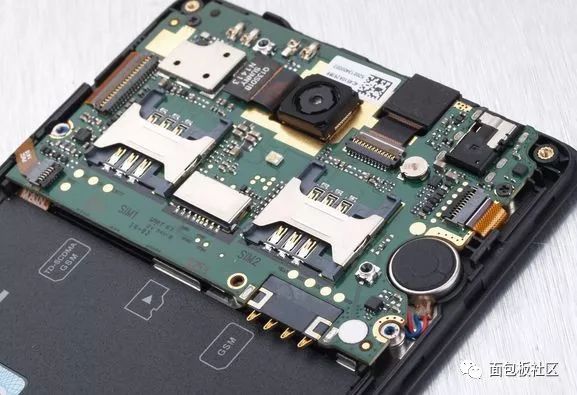
Mobile phone circuit board
A high-end smartphone must filter the transmit and receive paths of 2G, 3G, and 4G wireless access methods in up to 15 bands, including filtering for Wi-Fi, Bluetooth, and GPS receivers. . The signals of each receive path must be isolated. It is also necessary to suppress other external signals that are too numerous to be exhausted. To do this, a multi-band smartphone requires eight or nine filters and eight duplexers. This would be difficult to achieve without acoustic filtering techniques.
Just hearing so many components mentioned above will give you a feeling of bloatedness. However, many communication systems have developed to a certain extent and there will be a trend toward miniaturization. On the one hand, miniaturization can make the system lighter and more efficient. On the other hand, the growing IC manufacturing technology can produce large quantities of small products at a lower cost.
MEMS is one of the related technologies for this small product. MEMS can detect changes in the environment and generate related reactions through microcircuits. The main components of MEMS include sensors (microsensors) or actuators (microactuators) and transducers (transformers), where sensors can detect the presence or intensity of a physical, chemical or biological, such as temperature, pressure, sound or chemical composition. The transducer converts one energy into another (such as from electrical signals to mechanical waves). Currently MEMS are widely used in many fields.
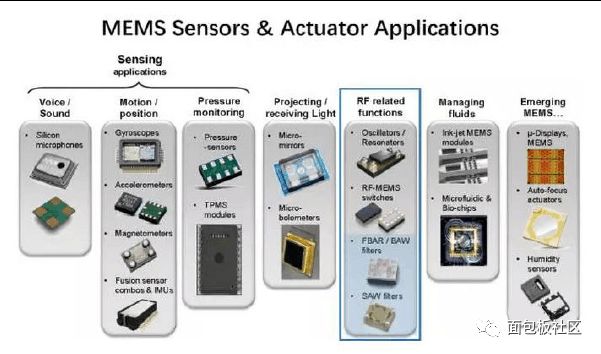
Today, small E mainly talks about several RF related applications of MEMS, SAW, BAW, FBAR filter, which are also the most commonly used filters in mobile phones.
(1) SAW filter
Surface acoustic wave filter (SAWF) is a translating passive band made by utilizing the piezoelectric effect of piezoelectric quartz crystal oscillator material such as piezoelectric ceramic, lithium niobate or quartz, and the physical properties of surface acoustic wave propagation. The pass filter is a filter-dedicated device which is made of a piezoelectric material such as a quartz crystal or a piezoelectric ceramic, and utilizes its piezoelectric effect and physical properties of surface acoustic wave propagation.
Surface acoustic wave (SAW) technology is an emerging field of science and technology that was developed in the late 1960s. It is an interdisciplinary subject combining acoustics and electronics. The development of surface acoustic wave technology is quite rapid. Its application field has evolved from the initial military radar to the entire radio communication, especially the rapid development of mobile communication technology, which further promotes the development of surface acoustic wave technology.
SAW filters are widely used in color televisions, mobile phones, GPS positioning, satellite communications and cable television.
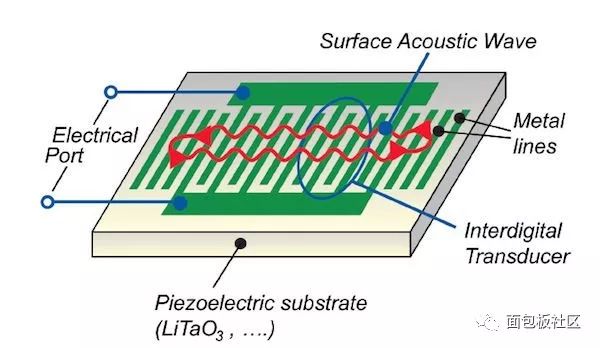
Basic SAW filter
Surface acoustic wave filter characteristics
1. Stable performance: high reliability, strong anti-interference ability, not easy to aging.
2. Easy to use: only need to insert and weld when assembling, no need to adjust and other operations.
3. Good selectivity: The selectivity can generally reach about 140dB, which ensures the clarity of the image.
4. Frequency bandwidth: The dynamic range is large, and the center frequency is not affected by the signal strength, which can ensure the normal transmission of images, color TVs and sounds without mutual interference.
5. Large insertion loss: In use, the band amplifier should be widened in the front stage to compensate for the insertion loss.
The characteristics of the SAW SAW filter are adapting to the requirements of modern communication system equipment and mobile communication, such as thin and light, high frequency, digitization, high performance and high reliability.
However, the SAW SAW filter also has its shortcomings: the required substrate material is expensive, and the substrate orientation, cutting, grinding, polishing and manufacturing processes are required to be high, and the substrate crystallization process is severe and the manufacturing precision is strict. influences.
(B) BAW filter
Compared to the SAW filter, the BAW filter is more suitable for high frequencies. Like the SAW/TC-SAW filter, the size of the BAW filter also decreases with increasing frequency. In addition, the BAW filter has the advantages of being insensitive to temperature changes, small insertion loss, and steep filter skirts.
Although the SAW and TC-SAW filters are well suited for applications up to about 1.5 GHz, BAW filters have performance advantages above 1.5 GHz, as shown. The size of the BAW filter also shrinks with increasing frequency, making it ideal for demanding 3G and 4G applications. In addition, even in high-bandwidth designs, BAW is less sensitive to temperature changes, and it has extremely low losses and very steep filter skirts.
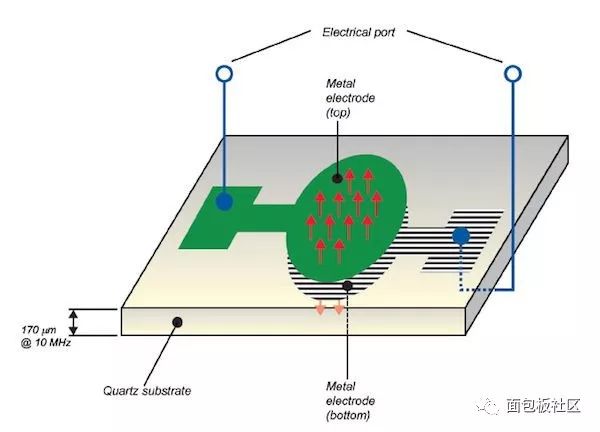
Unlike the SAW filter, sound waves propagate vertically in the BAW filter, as shown in the figure. As can be seen from the name, SAW is the surface, which propagates along the surface, and BAW is the bulk, which propagates inside the object. For a BAW resonator using a quartz crystal as a substrate, the metal attached to both sides of the top and bottom of the quartz substrate excites the sound wave to cause the sound wave to bounce from the top surface to the bottom to form a standing acoustic wave. The slab thickness and the mass of the electrode determine the resonant frequency. In the high frequency of the BAW filter, the thickness of the piezoelectric layer must be on the order of several micrometers. Therefore, the resonator structure is realized by thin film deposition and micromachining techniques on the carrier substrate.
In order to make the sound waves not diffuse onto the substrate, an acoustic Bragg reflector is formed by stacking thin layers of different stiffness and density. This method is known as a BAW or BAW-SMR device that securely mounts the resonator.
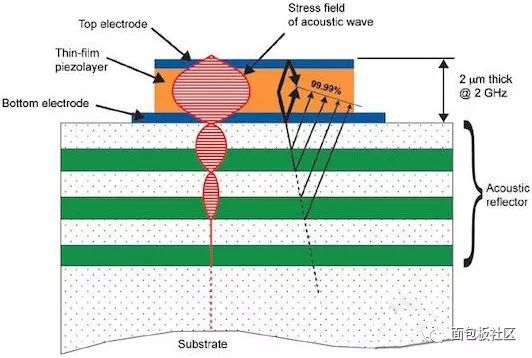
BAW-SMR device
(three) FBAR filter
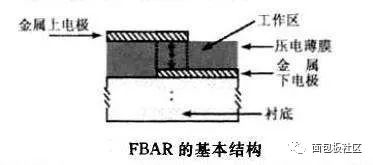
The fbar filter is the abbreviation of the film bulk acoustic resonator filter. It is translated into a thin film cavity acoustic resonator filter. The fbar filter is different from the previous filter. It is manufactured using a silicon backplane, using mems technology and thin film technology. The fbar filter already has a slightly higher performance than the normal saw filter.
In the next generation of wireless communication and wireless access products, today's wireless mobile products are more versatile, multi-band, multi-system, multi-protocol in addition to volume and power saving requirements. Integration and integration.
In addition to the volume and power saving requirements of today's wireless mobile products, the development of multi-function, multi-band, multi-system, multi-protocol integration and integration. Such as: gsm, cdma, wcdma and gps, bluetooth, wifi, wimax and other different functions combined in one product. This also poses challenges for design and mass production, and designers should consider the maturity and sustainability of the technology when choosing a solution.
The trend of the filter market in the next 5 years
The whole machine is getting smaller and smaller, the frequency resources are getting more and more crowded, and the high-performance filter is especially important.
The manufacturing process steps required for BAW devices are 10 times that of SAW, but because they are fabricated on larger wafers, the BAW devices produced per wafer are about four times larger. Even so, the cost of BAW is still higher than SAW. However, for some of the most challenging frequency bands allocated above 2 GHz, BAW is the only available solution. As a result, the share of BAW filters in 3G/4G smartphones is growing rapidly.
Solid-state capacitors / Motor starting capacitors
Solid - state capacitors are all called: solid - state Aluminum Electrolytic Capacitors.It with the ordinary capacitance (that is, the liquid aluminum electrolytic capacitors) the biggest difference is that use different dielectric material, liquid aluminum capacitor dielectric material as the electrolyte, and solid-state capacitor dielectric material is conductive polymer materials.Solid-state Capacitors / Motor Starting Capacitors
Solid-state capacitors / Motor starting capacitors,Solid-State Capacitors,Solid-State Small Size Capacitors,Solid-State Low Impedance Capacitors,Long Life Solid-State Capacitors
YANGZHOU POSITIONING TECH CO., LTD. , https://www.cnpositioning.com
![<?echo $_SERVER['SERVER_NAME'];?>](/template/twentyseventeen/skin/images/header.jpg)